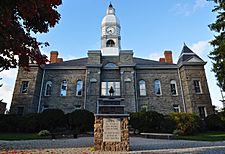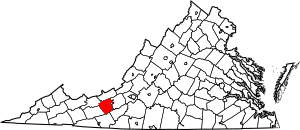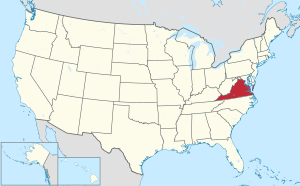Pulaski County, Virginia facts for kids
Quick facts for kids
Pulaski County
|
||
|---|---|---|

Pulaski County Courthouse
|
||
|
||

Location within the U.S. state of Virginia
|
||
 Virginia's location within the U.S. |
||
| Country | ||
| State | ||
| Founded | 1839 | |
| Named for | Casimir Pulaski | |
| Seat | Pulaski | |
| Largest town | Pulaski | |
| Area | ||
| • Total | 330 sq mi (900 km2) | |
| • Land | 320 sq mi (800 km2) | |
| • Water | 10 sq mi (30 km2) 3.0% | |
| Population
(2020)
|
||
| • Total | 33,800 |
|
| • Density | 100/sq mi (40/km2) | |
| Time zone | UTC−5 (Eastern) | |
| • Summer (DST) | UTC−4 (EDT) | |
| Congressional district | 9th | |
Pulaski County is a county located in the southwestern part of the U.S. state of Virginia. As of the 2020 census, the population was 33,800. Its county seat is Pulaski. Pulaski County is part of the Blacksburg–Christiansburg, VA Metropolitan Statistical Area.
Contents
History
Pulaski County was formed on March 30, 1839, from parts of Montgomery and Wythe counties, becoming the 87th county of the Commonwealth of Virginia. It was named for Count Casimir Pulaski, an exiled Polish nobleman who fought during the American Revolution as part of George Washington's army. He joined the army in 1777 and became a brigadier general and chief of cavalry in the Continental Army. He was fatally wounded at Savannah and died on October 11, 1779.
This area of the Blue Ridge has rolling hills and was settled by mostly small farmers, recent Scots-Irish and German immigrants and their descendants who migrated down the Shenandoah Valley from Pennsylvania in the mid to late-18th century. They pushed out or killed most Native Americans in the area. The new settlers were yeomen, who held fewer slaves than in the Tidewater area. Nonetheless, by 1840 about one-quarter of the population was made up of enslaved black Americans. The county had 3,739 persons, consisting of 2,768 free whites, and 971 blacks. Some 17 of the latter were free blacks.
Geography
According to the U.S. Census Bureau, the county has a total area of 330 square miles (850 km2), of which 320 square miles (830 km2) is land and 10 square miles (26 km2) (3.0%) is water. Pulaski County is one of the 423 counties served by the Appalachian Regional Commission, and it is identified as part of "Greater Appalachia" by Colin Woodard in his book American Nations: A History of the Eleven Rival Regional Cultures of North America.
Pulaski County is the site of Claytor Lake State Park, which is located on Claytor Lake, a 4,500-acre (18 km2), 21-mile (34 km) long human-made lake on the New River created for a hydroelectric project of Appalachian Power Company. Claytor Lake State Park, located on the north side of the lake, provides 497 acres of park with camping, cabins, picnic areas, and a swimming beach, as well as a marina. It is named for W. Graham Claytor, Sr. (1886–1971) of Roanoke, Virginia, a vice president of Appalachian Power who supervised construction of the dam and creation of the lake.
Pulaski County has several public boating sites including Harry DeHaven Park, in Allisonia on Rt.639, in Dublin on Rt. 660, and Gatewood Reservoir, a 162-acre water supply impoundment owned by the Town of Pulaski.
Adjacent counties / Independent city
- Bland County, Virginia – northwest
- Giles County, Virginia – north
- Montgomery County, Virginia – northeast
- Radford, Virginia – northeast
- Floyd County, Virginia – southeast
- Carroll County, Virginia – south
- Wythe County, Virginia – southwest
Law Enforcement
Pulaski County Sheriff is Michael W. Worrell, a law enforcement veteran with twenty plus years of service to the citizens of Pulaski County. He is a graduate of Pulaski County High School and Radford University.
National protected area
- Jefferson National Forest (part)
Major highways
 I-81
I-81 US 11
US 11 SR 99
SR 99 SR 100
SR 100 SR 114
SR 114 SR 9
SR 9
Demographics
| Historical population | |||
|---|---|---|---|
| Census | Pop. | %± | |
| 1840 | 3,739 | — | |
| 1850 | 5,118 | 36.9% | |
| 1860 | 5,416 | 5.8% | |
| 1870 | 6,538 | 20.7% | |
| 1880 | 8,755 | 33.9% | |
| 1890 | 12,790 | 46.1% | |
| 1900 | 14,609 | 14.2% | |
| 1910 | 17,246 | 18.1% | |
| 1920 | 17,111 | −0.8% | |
| 1930 | 20,566 | 20.2% | |
| 1940 | 22,767 | 10.7% | |
| 1950 | 27,758 | 21.9% | |
| 1960 | 27,258 | −1.8% | |
| 1970 | 29,564 | 8.5% | |
| 1980 | 35,229 | 19.2% | |
| 1990 | 34,496 | −2.1% | |
| 2000 | 35,127 | 1.8% | |
| 2010 | 34,872 | −0.7% | |
| 2020 | 33,800 | −3.1% | |
| U.S. Decennial Census 1790–1960 1900–1990 1990–2000 2010 2020 |
|||
2020 census
| Race / Ethnicity | Pop 2010 | Pop 2020 | % 2010 | % 2020 |
|---|---|---|---|---|
| White alone (NH) | 31,972 | 29,716 | 91.68% | 87.92% |
| Black or African American alone (NH) | 1,744 | 1,633 | 5.00% | 4.83% |
| Native American or Alaska Native alone (NH) | 61 | 49 | 0.17% | 0.14% |
| Asian alone (NH) | 179 | 177 | 0.51% | 0.52% |
| Pacific Islander alone (NH) | 7 | 3 | 0.02% | 0.01% |
| Some Other Race alone (NH) | 25 | 100 | 0.07% | 0.30% |
| Mixed Race/Multi-Racial (NH) | 452 | 1,418 | 1.30% | 4.20% |
| Hispanic or Latino (any race) | 432 | 704 | 0.96% | 2.08% |
| Total | 34,872 | 33,800 | 100.00% | 100.00% |
Note: the US Census treats Hispanic/Latino as an ethnic category. This table excludes Latinos from the racial categories and assigns them to a separate category. Hispanics/Latinos can be of any race.
Economy
The Volvo Trucks North America plant in Pulaski County will begin manufacturing a battery-powered VNR Electric truck model starting in early 2021. It is the largest Volvo truck plant in the world, and the Dublin, Virginia facility currently employed close to 3,000 people building multiple models of heavy-duty trucks.
Schools
Secondary and Higher Education
- New River Community College
- Southwest Virginia Governor School
- Pulaski County High School
Middle schools
- Pulaski County Middle School
Elementary schools
- Pulaski Elementary School
- Dublin Elementary School
- Critzer Elementary School
- Riverlawn Elementary School
- Snowville Elementary School
Communities
Towns
Census-designated places
Other unincorporated communities
- Caseknife
- Claytor Lake
- Newbern
- Wurno
- Little Creek
- Delton
- Tinytown
See also
 In Spanish: Condado de Pulaski (Virginia) para niños
In Spanish: Condado de Pulaski (Virginia) para niños


